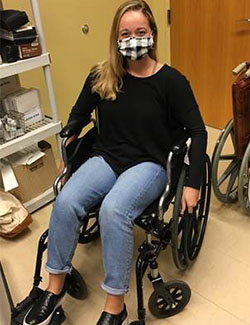Class Project Highlights Campus Accessibility Issues

Editor’s Note: Ms. Osborne’s article is an example of the matters brought to the attention of the ADA-Rehabilitation Act Steering Committee, a presidentially appointed group of faculty and staff dedicated to addressing disability, accessibility and accommodation at Stockton University. We thank Ms. Osborne and her classmates for their observations, which will be considered by the Division of Facilities and Operations, as well as the Steering Committee.
As the calendar flipped to October, we began the month-long celebration of National Disability Employment Awareness Month. This commemoration not only celebrates the contributions of individuals with disabilities to their workplaces, but also brings awareness to the importance of inclusivity and accessibility within all workplace environments. When an individual is able to safely and independently navigate within their environment, they are provided with the opportunity to be successful in their daily work activities.
As a graduate student in Stockton’s Occupational Therapy program, my classmates and I were tasked with traveling through campus in wheelchairs to gain our own insight on the successes and challenges that come with community wheelchair mobility. Though accessibility for all individuals should be at the forefront of design conception, a quick trek through Stockton’s Galloway campus will uncover the shortcomings of accessible environments, especially for those with physical disabilities.
National Disability Employment Awareness Month should serve as a reminder for facilities and employers to check in on their work spaces to ensure accessibility, safety and inclusivity for all individuals and identify areas of improvement.
Many doors are found without the automatic open and close buttons. Because the doors are laborious to push or pull open, the absence of these buttons increases the time it takes to enter and exit, energy expenditure and safety risks. Thresholds, where hard flooring meets carpet, also add to the complexity of pushing through doorways because they create an added barrier for the wheelchair to clear. These thresholds are usually for cosmetic purposes and would be an easy omission for facilities to create more accessible entrances and exits.
Various handicap bathroom stalls may appear roomy, but the addition of a wheelchair quickly shrinks the space available to complete safe transfers. Some handicap bathroom doors are found to swing inward, which also decreases space for bathroom mobility. Elevator access is abundant throughout campus, which is a success for Stockton’s accessibility. Signage to direct users to these elevators should be increased within each building to further improve navigation and mobility.
The stated observations may be a challenge to change at present-day but could call attention to important aspects of accessibility considerations for future building projects.
National Disability Employment Awareness Month should serve as a reminder for facilities and employers to check in on their workspaces to ensure accessibility, safety and inclusivity for all individuals and identify areas of improvement.


